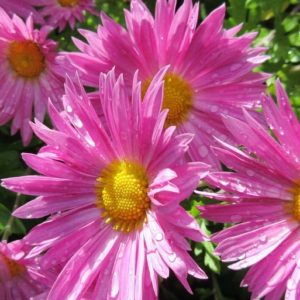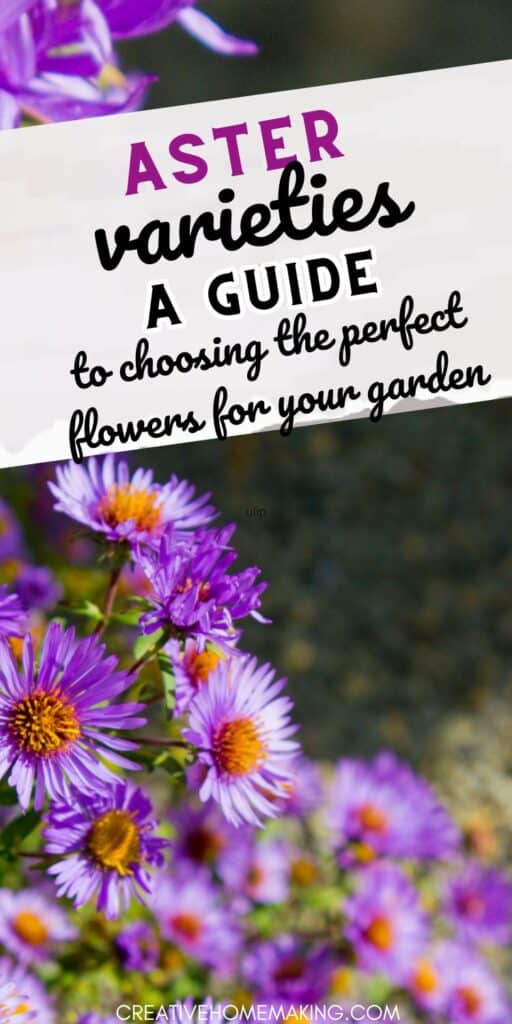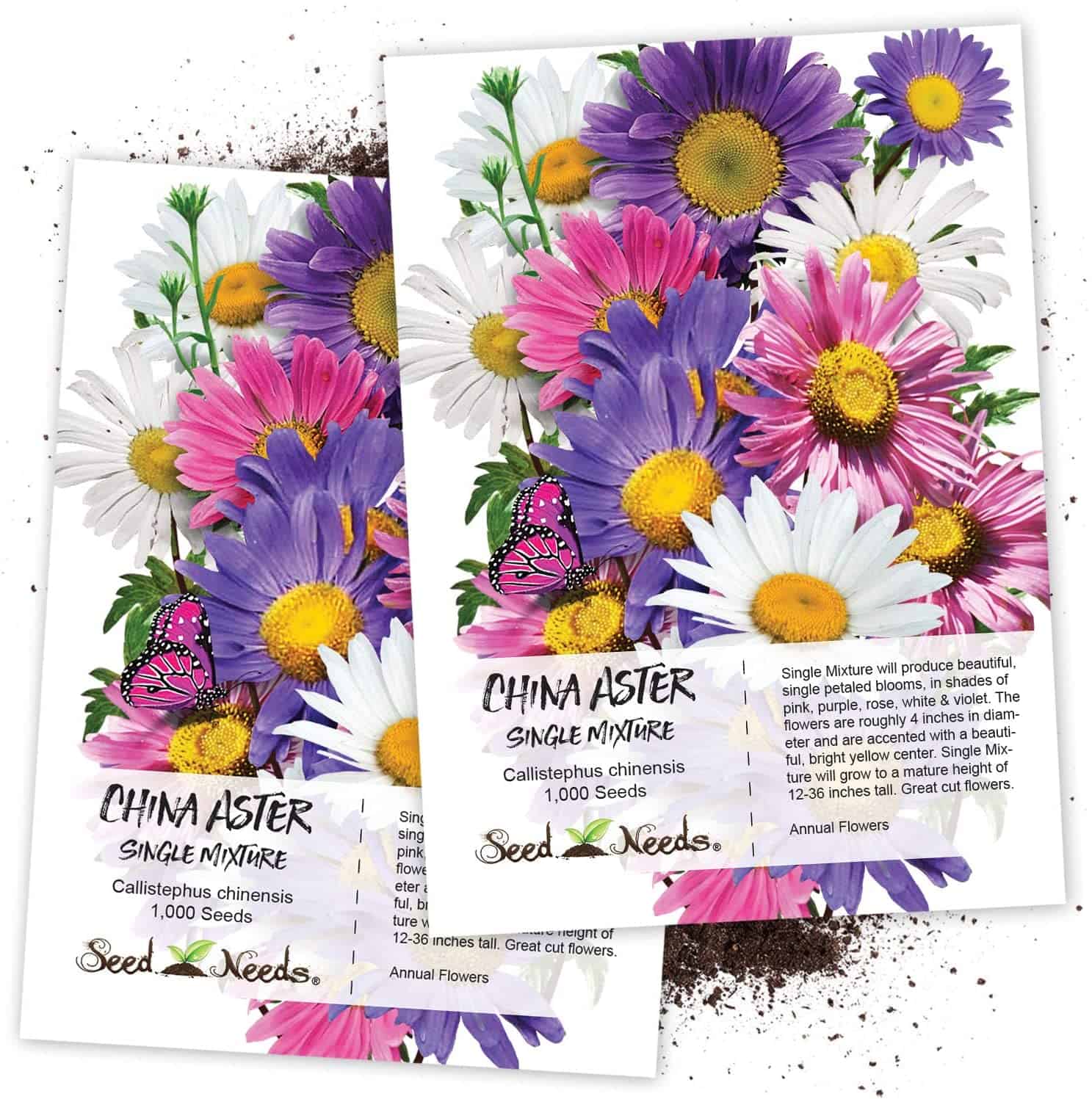Are you looking to add more aster varieties and some more color to your garden? Look no further than asters! Asters come in a wide range of sizes and colors, making them a popular choice for gardeners of all levels.
This post may contain affiliate links.
Asters are a type of flowering plant that belong to the Asteraceae family. They are known for their daisy-like flowers, which can range in color from white and pink to purple and blue.
There are over 600 species of asters, with varieties that grow in almost every region of the world.
In addition to their beauty, asters are also valued for their hardiness and versatility. They can be grown in a variety of soil types and light conditions, and are often used in borders, rock gardens, and wildflower meadows.
With so many varieties to choose from, there’s sure to be an aster that’s perfect for your garden.
Understanding Asters
Asters are a popular choice for gardens due to their vibrant colors and easy-to-grow nature. In this section, we will cover the basics of aster varieties, their species diversity, and the different cultivars and hybrids available.
Aster Basics
Asters are a type of perennial flower that belong to the Asteraceae family. They are known for their daisy-like appearance, with a central disk surrounded by petals. Asters come in a variety of colors, including white, pink, purple, and blue.
Related Article: Irises Not Blooming: Possible Reasons and Solutions
One of the most popular species of aster is the New England aster (Aster novae-angliae), which is native to North America. Another popular species is the New York aster (Aster novi-belgii), which is also native to North America.
Asters are easy to grow and care for. They prefer full sun and well-draining soil. They also require regular watering, especially during periods of drought.
Seed Needs, Single Mix China Aster (Callistephus chinensis) Twin Pack of 1,000 Seeds Each
Species Diversity
There are over 600 species of aster, with a wide range of shapes, sizes, and colors. Some of the most popular species include:
- Aster amellus: This species is native to Europe and has purple flowers.
- Aster novae-angliae and Aster novi-belgii: These species are native to North America and has pink, purple, or white flowers.
Cultivars and Hybrids
There are many different aster varieties available. These plants have been bred for their unique colors, shapes, and sizes. Some popular cultivars include:
- ‘Purple Dome’: This cultivar has a compact, mounding habit and purple flowers.
- ‘Alma Potschke‘: This cultivar has bright pink flowers and a tall, upright habit.
- ‘Hella Lacy’: This cultivar has white flowers with a yellow center and a spreading habit.
When selecting asters for your garden, consider the species, cultivar, and growing conditions to ensure the best results. With their vibrant colors and easy care, asters are a great addition to any garden.
Related Article: How to Deadhead Zinnias: A Friendly Guide
Planting and Care
Soil and Sun Requirements
Asters thrive in full sun and well-drained soil. If you have heavy clay soil, consider adding compost to improve drainage and soil quality. Asters can also grow in partial shade, but they may not produce as many flowers.
Watering and Maintenance
Asters prefer moist soil, so be sure to water them regularly, especially during hot and dry weather. Avoid overwatering, as this can lead to root rot.
Deadhead spent flowers to encourage more blooms and prevent self-seeding. If your asters become crowded, divide them in the spring to promote healthy growth.
Planting Tips
When planting asters, choose a location that receives at least six hours of direct sunlight per day. If you are planting in containers, make sure they are large enough to accommodate the root system.
Dig a hole slightly larger than the root ball and backfill with soil, gently pressing down to eliminate air pockets. Water thoroughly after planting and monitor soil moisture regularly.
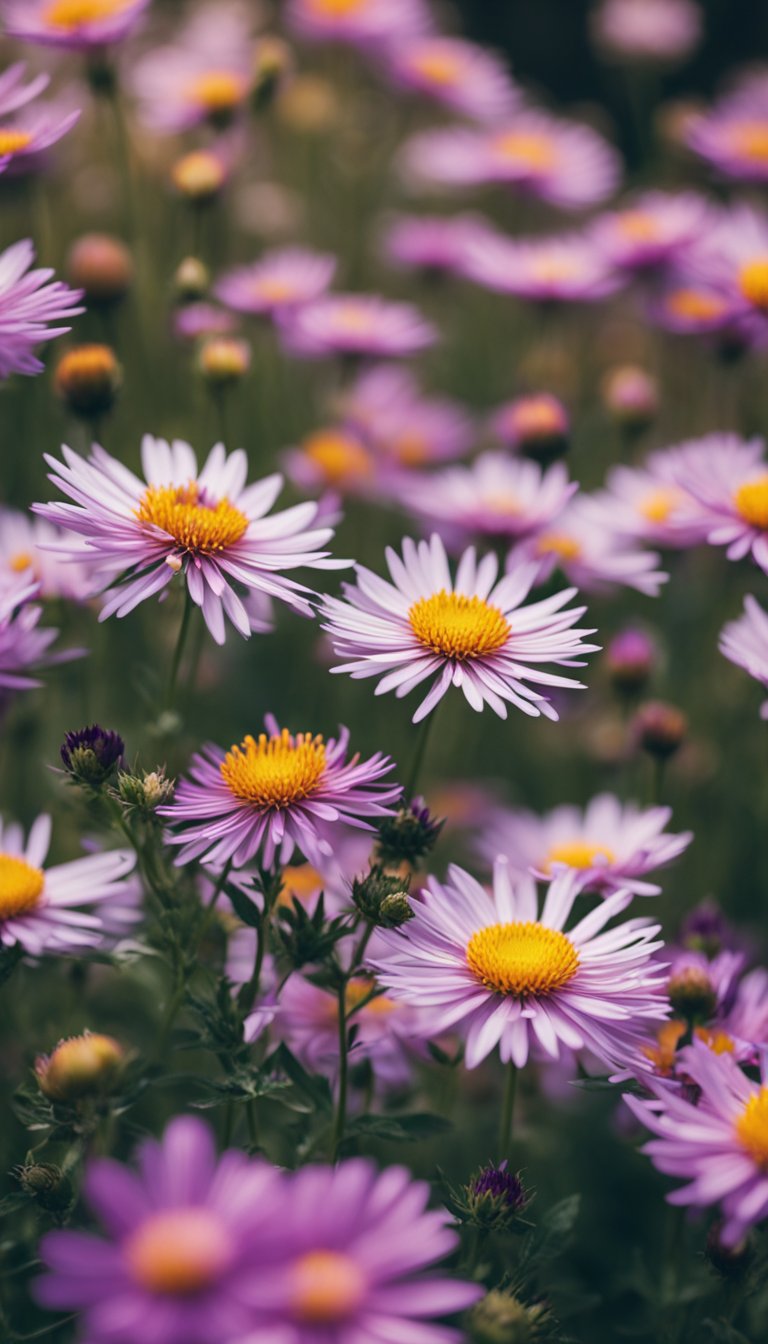
Aster Varieties by Color
If you’re looking to add some color to your garden, asters are a great option. With their wide range of colors, you’re sure to find one that fits your style. Here are some popular aster varieties by color:
Purple Asters
Purple asters are a classic choice for any garden. They come in a variety of shades, from pale lavender to deep purple.
One popular variety is the Purple Dome aster, which has a compact, mounding habit and produces large, vibrant purple flowers.
Pink Asters
Pink asters are a great way to add a soft, romantic touch to your garden. They come in shades ranging from pale pink to bright fuchsia. One popular variety is the Royal Ruby aster, which produces deep pink, double flowers with yellow centers.
Miracle-Gro Shake ‘N Feed All Purpose Plant Food, 4.5 lbs, Covers up to 180 sq. ft.
White Asters
White asters are a timeless choice that pairs well with any other color in your garden. They come in a variety of shapes and sizes, from small daisy-like flowers to large, fluffy blooms.
One popular variety is the Snow Flurry aster, which produces pure white, semi-double flowers with yellow centers.
Blue Asters
Blue asters are a unique and eye-catching addition to any garden. They come in shades ranging from pale lilac-blue to deep navy.
One popular variety is the Lavender Blue aster, which produces large, semi-double flowers with a unique blue-lavender hue.
No matter which color you choose, asters are a great way to add some color and texture to your garden.
With their wide range of shapes and sizes, you’re sure to find a variety that fits your style.
Aster Growth Habits
Asters are a popular choice for gardeners because of their attractive blooms and easy-to-grow nature.
Different aster varieties have different growth habits, so it’s important to choose the right one for your landscape or garden bed.
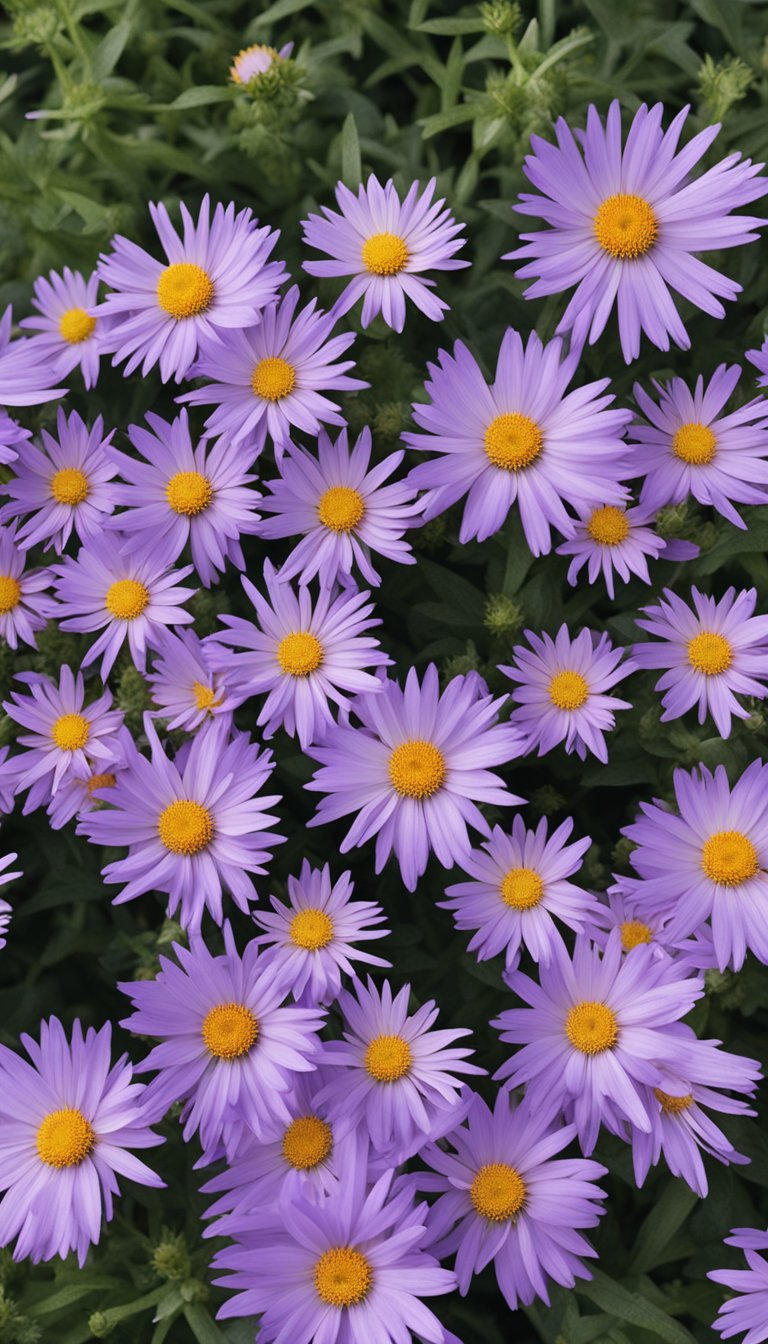
Height Variations
Aster plants can range in height from just a few inches to several feet tall. Taller varieties of asters, such as the New England aster, can grow up to six feet tall, while shorter varieties, such as the alpine aster, only grow to be a few inches tall.
Dwarf asters are also available for those who want a smaller plant.
When choosing an aster variety, consider the height you want for your garden bed or landscape. Taller varieties can be used as a backdrop for shorter plants, while shorter varieties can be used as ground cover or in rock gardens.
Spread and Coverage
Aster plants can also vary in their spread and coverage. Some asters, such as the China aster, have a bushy growth habit and can cover a large area, while others, such as the wood aster, have a more compact growth habit and are better suited for smaller spaces.
Consider the amount of space you have available when choosing an aster variety. Asters can be used in wildflower gardens, garden beds, or rock gardens, so choose a variety that will fit well with the other plants in your landscape.
Asters in the Ecosystem
Not only are asters beautiful flowers to look at, but they also play an important role in the ecosystem. Here are some ways in which asters contribute to the environment:
Attracting Pollinators
Asters are a great source of nectar for pollinators such as bees, butterflies, and flies. Bees are especially attracted to asters as they produce large amounts of pollen, making them an important food source for bees during the fall season.
Butterflies are also attracted to asters, and their bright colors and sweet scent make them a popular choice for butterfly gardens. Flies are also attracted to asters, and they help in the pollination process as well.
Natural Habitats
Asters are native to North America and are an important part of the wildflower gardens. They grow in a variety of habitats, including meadows, prairies, and woodlands. Asters are also drought-tolerant, making them a great choice for gardens in areas with low rainfall.
Asters provide food and shelter for a variety of wildlife, including birds and insects. Their seeds are a valuable food source for birds during the winter months. In addition, asters provide shelter for insects during the colder months, which helps to maintain a healthy ecosystem.
Seasonal Aspects of Asters
If you’re looking for a flower that will add color and interest to your garden throughout the growing season, asters are an excellent choice. These hardy perennials come in a wide range of colors and sizes, making them versatile enough to fit into almost any garden design.
Blooming Seasons
One of the great things about asters is that they bloom at different times throughout the growing season, so you can enjoy their colorful flowers for months on end.
Some varieties, such as the New England aster, bloom in late summer, while others, like the Michaelmas daisy, bloom in the fall. If you want to extend the blooming season even further, you can plant both early and late-blooming varieties in your garden.
Late Summer and Fall Interest
Late summer and fall are the perfect times to showcase your asters. Their rich, vibrant colors are a welcome sight as the days start to get shorter and the temperatures begin to drop.
In fact, asters are sometimes called “Michaelmas daisies” because they typically bloom around the time of the Feast of St. Michael in late September.
To get the most out of your asters, plant them in a sunny location with well-drained soil. They prefer soil that is slightly acidic, so you may need to amend your soil if it is too alkaline. Once established, asters require very little maintenance, making them a great choice for busy gardeners.
Designing with Asters
When it comes to designing your garden or landscape, asters can be a versatile and colorful addition. Here are some tips on how to use asters in your design.
Landscape Use
Asters can be used in a variety of landscape settings, including borders, garden beds, and containers. They can add color and texture to your garden throughout the growing season. Asters are also great for attracting butterflies and other pollinators.
If you’re looking for a low-maintenance option, consider planting asters in a naturalized meadow or wildflower garden. Asters can also be used as a groundcover, particularly in areas where other plants struggle to grow.
Companion Planting
Asters can be paired with a variety of other plants to create a beautiful and functional garden. They look particularly stunning when planted with other fall-blooming perennials, such as mums and sedums.
You can also pair asters with grasses and other ornamental plants to create a visually interesting garden bed. Asters can also be used as a cut flower in floral arrangements, adding a pop of color and texture to your vase.
When designing with asters, consider the color and height of the plant, as well as its bloom time. By choosing the right varieties and pairing them with complementary plants, you can create a stunning garden that will be the envy of your neighborhood.
Aster Care Challenges
Growing asters can be a rewarding experience, but it is not without its challenges. Here are some common issues you may face when caring for your aster plants:
Common Pests and Diseases
Aster plants can be susceptible to a variety of pests and diseases, including aphids, spider mites, powdery mildew, and rust. To prevent these problems, make sure to keep your plants well-watered and fertilized, and remove any dead or diseased plant material promptly.
Soil and Climate Considerations
Asters prefer well-draining soil that is rich in organic matter. They also require full sun to thrive, so make sure to choose a location that gets at least six hours of direct sunlight per day.
If you live in a region with cold winters, choose a hardy aster variety that can withstand freezing temperatures.
When planting asters, make sure to space them at least 12 inches apart to allow for proper air circulation. This will help prevent the spread of diseases such as powdery mildew.
If you live in an area with sandy or clay soil, you may need to amend the soil with compost or other organic matter to improve drainage and fertility. Asters can also be grown in containers filled with a well-draining potting mix.
By taking these steps and staying vigilant for signs of pests and diseases, you can enjoy a healthy and vibrant aster garden.
Propagating Asters
Asters are a beautiful addition to any garden, and propagating them is a great way to get more of these lovely flowers. There are two main ways to propagate asters: seed starting and division and cuttings.
Seed Starting
Starting asters from seed is relatively easy. You can start them indoors in late winter or early spring, or you can sow them directly in the garden in the spring or fall. Here’s how to do it:
- Start by filling a seed tray or small pots with a good quality seed starting mix.
- Sow the seeds on the surface of the soil, and then cover them lightly with more soil.
- Water the soil well, and then cover the tray or pots with plastic wrap to keep the moisture in.
- Place the tray or pots in a warm, bright location, such as a sunny windowsill or under grow lights.
- Keep the soil moist, but not waterlogged, and the seeds should germinate in 7-14 days.
- Once the seedlings have developed their second set of true leaves, you can transplant them into larger pots or into the garden.
Division and Cuttings
If you already have established asters in your garden, you can propagate them by division or cuttings. Here’s how to do it:
- For division, dig up the entire plant and carefully separate it into smaller sections, each with its own root system. Make sure each section has at least one healthy stem.
- Replant each section in a new location, and water well.
- For cuttings, take a stem cutting from the parent plant that is about 4-6 inches long, and remove the bottom leaves.
- Dip the cut end of the stem in rooting hormone, and then plant it in a pot filled with a good quality potting mix.
- Water the soil well, and then cover the pot with plastic wrap to keep the moisture in.
- Place the pot in a warm, bright location, and keep the soil moist.
- After a few weeks, the cutting should have developed roots and can be transplanted into the garden.
By using these propagation methods, you can grow more asters to enjoy in your garden. Whether you choose to start from seed or propagate from an established plant, asters are a beautiful addition to any garden.
Aster Varieties for Special Uses
Container Gardening
Asters are a great choice for container gardening, as they are easy to grow and come in a variety of colors. Dwarf and compact varieties, such as the ‘Alpine’ and ‘Dwarf Queen’ asters, are perfect for small containers and can be grown on patios or balconies.
They require well-draining soil and regular watering, but can tolerate some drought.
When planting asters in containers, make sure to choose a pot that is at least 6 inches deep and has drainage holes. Fill the container with a good quality potting soil and add some compost for added nutrients.
Plant the asters at the same depth as they were in their original container and water thoroughly.
Cut Flower Varieties
Asters are a popular choice for cut flowers, as they have long stems and come in a range of colors, from white and pink to purple and blue. Some popular cut flower varieties include the ‘Matsumoto’ and ‘Monte Casino’ asters.
When cutting asters for a vase, make sure to cut them in the morning when they are at their freshest. Remove any leaves that will be below the water line and place them in a vase filled with fresh, cool water.
Change the water every few days and trim the stems every few days to keep them fresh.
Aster Folklore and Symbolism
Asters varieties have been associated with various folklore and symbolism throughout history. Here are some of the most common beliefs:
- Love: In ancient times, it was believed that burning aster leaves would attract the love of Venus, the Roman goddess of love. Asters were also used in love potions and spells.
- Fellowship: Asters were often given as gifts to symbolize friendship and loyalty. In fact, the name “aster” comes from the Greek word for “star”, which was thought to represent the bond between friends.
- Grunder: In German folklore, it was believed that placing aster flowers on the graves of loved ones would bring them peace and protect them from evil spirits.
- Monch: In some cultures, aster flowers are used in religious ceremonies to symbolize purity and innocence.
Glossary of Aster Terms
Asters are a beautiful and popular flowering plant that comes in a variety of cultivars, perennials, hybrids, and species. Here are some common terms you should know when it comes to asters:
- Cultivars: A plant variety that has been bred for specific characteristics, such as color, size, or disease resistance. Some popular aster cultivars include ‘Purple Dome’, ‘Alma Potschke’, and ‘October Skies’.
- Perennials: A plant that lives for more than two years and comes back year after year. Many aster varieties are perennials, meaning they will come back each year with new growth and blooms.
- Hybrids: A plant that is created by crossing two different species or varieties. Hybrid asters can have unique characteristics that are a combination of the parent plants.
- New England asters: Also known as Symphyotrichum novae-angliae, these asters are native to North America and are known for their bright purple flowers and tall, sturdy stems.
- New York asters: Also known as Symphyotrichum novi-belgii, these asters are native to North America and are known for their wide range of colors, including pink, blue, and white.
- Aster flowers: The flower of the aster plant, which comes in a variety of colors and sizes. Aster flowers are often used in bouquets and floral arrangements.
- Flowering plant: A plant that produces flowers as part of its reproductive process. Asters are a popular flowering plant due to their beautiful blooms and easy care.
- Perennial aster: A type of aster that comes back year after year and requires little maintenance. Perennial asters are a great choice for gardeners who want a low-maintenance yet beautiful garden.
By understanding these common aster terms, you can better appreciate the beauty and diversity of this popular flowering plant.
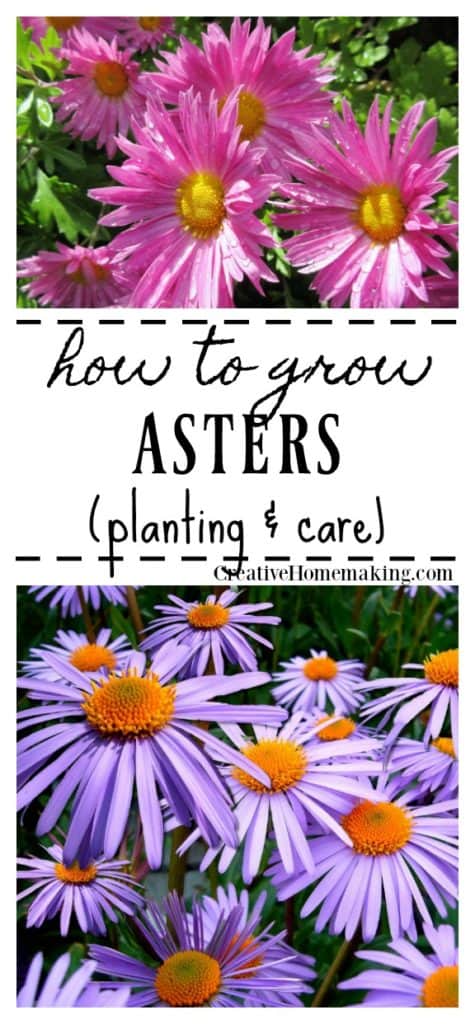
Frequently Asked Questions
If you’re new to growing aster varieties, you may have some questions about how to care for them. Here are some frequently asked questions to help you get started:
How often should I water my asters?
Asters prefer moist, well-drained soil. Water them deeply once a week, or more often during hot, dry weather. Avoid getting water on the leaves, as this can lead to fungal diseases.
Do asters need fertilizer?
Asters benefit from a balanced fertilizer applied in early spring. Use a slow-release fertilizer with equal amounts of nitrogen, phosphorus, and potassium. Avoid over-fertilizing, as this can lead to leggy growth and fewer flowers.
How do I deadhead my asters?
Deadheading, or removing spent flowers, can encourage your asters to produce more blooms. Simply pinch off the faded flowers with your fingers or use scissors. Be sure to remove the entire flower head, including the stem, to prevent seed production.
What pests and diseases should I watch out for?
Asters are generally resistant to pests and diseases, but they can be susceptible to powdery mildew and aster yellows. To prevent these problems, avoid overhead watering and provide good air circulation.
If you do spot signs of disease, remove affected leaves or plants promptly to prevent further spread.
Can I grow asters in containers?
Yes, asters can be grown in containers as long as the container is at least 12 inches deep and wide. Use a well-draining potting mix and water regularly. Fertilize every two weeks with a balanced fertilizer. Asters grown in containers may need staking to prevent them from falling over.
Follow my gardening board on Pinterest.
In case you missed it:
- Understanding Asters
- Planting and Care
- Aster Varieties by Color
- Aster Growth Habits
- Asters in the Ecosystem
- Seasonal Aspects of Asters
- Designing with Asters
- Aster Care Challenges
- Propagating Asters
- Aster Varieties for Special Uses
- Aster Folklore and Symbolism
- Glossary of Aster Terms
- Frequently Asked Questions
